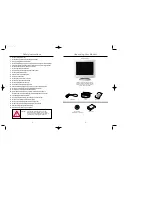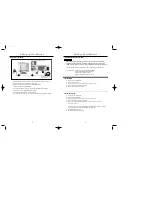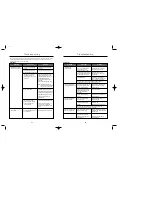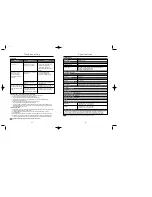
Setting up Your Monitor
9
Self-Test Feature Check
1.
Turn off both your computer and the monitor.
2.
Unplug the video cable from the back of the computer.
3.
Turn on the monitor.
If your monitor works normally, the following screen appears.
Your monitor provides a self test feature that allows you to check whether your monitor is
functioning properly.
10.
Linux Operating System
To execute X-Window, you need to make the X86Config file, which is a type of system setting file.
1.
Press Enter at the first and the second screen after executing the X86Config file.
2.
The third screen is for setting your mouse.
3.
Set a mouse for your computer.
4.
The next screen is for selecting a keyboard.
5.
Set a Keyboard for your computer.
6.
The next screen is for setting your monitor.
7.
First of all, set a horizontal frequency for your monitor. (You can enter the frequency directly.)
8.
Set a vertical frequency for your monitor. (You can enter the frequency directly.)
9.
Enter the model name of your monitor.
This information will not affect the actual execution of X-Window.
You have finished setting up your monitor.
Execute X-Window after setting other requested hardware.
8
Setting up Your Monitor
11.
Microsoft ® Windows ® Millennium Operating System
1.
Click “Start” , “Setting” , “Control Panel”.
2.
Double click “Display” icon.
3.
Select the “Settings” tab and click “Advanced Properties” button.
4.
Select the “Monitor” tab.
5.
Click the “Change” button in the “Monitor Type” area.
6.
Choose “Specify the location of the driver”.
7.
Choose “Display a list of all the driver in a specific location..” then click “Next” button.
8.
Click the “Have Disk” button.
9.
Specify A:\(D:\driver) then click “OK” button.
Select “Show all devices” and choose the monitor that corresponds to the one you
connected to your computer and click “OK”.
Continue choosing “Close” button and “OK” button until you close the Display
Properties dialogue box.
(You can get some other screen for warning message or others,
then click the appreciate option for your monitor.)
10.
Microsoft ® Windows ® NT Operating System
1.
Click Start, Settings, Control Panel, and then double-click Display icon.
2.
In Display Registration Information window, click Settings Tab and then click All Display Modes.
3.
Select a mode that you wish to use (Resolution, Number of colors and Vertical frequency)
and then click OK.
4.
Click Apply button if you see the screen working normally after clicking Test.
If the screen is not normal, change to a different mode (lower mode of resolution,
colors or frequency).
Note
If there is no Mode at All Display Modes, select the level of resolution and
vertical frequency by referring to the Preset Timing Modes in the user guide.


































